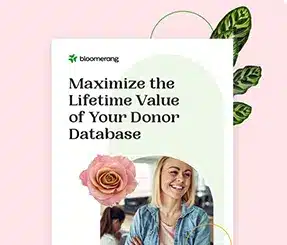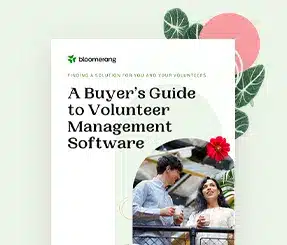Don’t Pitch, Connect: 10 Smart Moves for First Donor Meetings


Full Platform Overview Chat With Us



Full Platform Overview Chat With Us




Your first face-to-face meeting with a donor isn’t a sales pitch or interview. And it’s definitely not the time to comb through the details for your 30-page strategic plan. It’s a discovery conversation—a delightful dance where you listen, learn, and laugh.
Apply the following 10 tactics to get your first donor meeting right and the odds of landing a second meeting (and ultimately a donation) jump to more than 70%. Not bad for the cost of a latte and scone.
No one-size-fits-all here. Meet donors where they’re most comfortable: their office, the golf course, a corner café, the top of a ski lift—yes, it’s happened.
Let the donor choose. But if they hesitate, suggest a couple options that are stylish, not showy. Avoid noisy and crowded cafes and restaurants. Think casual, quiet, comfortable. And think about logistics. Pick a place that is convenient for them to travel to. You don’t want a donor traveling through downtown Los Angeles at noon to meet you 10 miles away for lunch.
Want to make a good impression? Quietly pick up the tab. Arrive early. Hand your card to the server. At the end of the meal, have them bring the check, already paid. This tactic will go over as smooth as buttery jazz.
You’re not there to dominate, but you are there to guide. Steer the tone, pace, and flow of the conversation. Keep it genuine. Keep it two-way. If the donor launches into a story about their pet raccoon, listen. Nod. Smile. And when the moment’s right, guide things gently back to discussion about your organization’s work, impact, and vision.
Start light, then dig deeper. Ask about hobbies, history, family, and what lights their philanthropic fire. Listen. Really listen. If they’re not talking 60% of the time, you’re monologuing, which can distract the donor and cause them to lose interest in you and the organization.
Example questions:
“Sarah, how did you meet our board chair, John?”
“What did you enjoy most about working at the embassy in Switzerland?”
“You mentioned you’ve had a long-time interest in helping abused children; why this issue?”
Donors give to people they like and trust. In fact, after four years, one of the top reasons donors continue to give to an organization, isn’t because of the mission, it’s because of the relationship the donor has with the person asking them for money.
But what if they don’t ask about you? Then sprinkle in your backstory casually. Be humble, but confident. Two minutes or less. Think ‘heartfelt bio’ not ‘résumé recital.’ Let them feel your passion, hear your energy, and see your sincerity. And be sure to toss in some personal data about a favorite hobby, interest, or how you got involved with the organization.
This is the heart of your meeting. Share stories that show your nonprofit is the rocket fuel for their philanthropic dreams. Align values. Meaning, look for ways to align the issues and things they care about with issues and things your organization is addressing. Share impact in a way that’s meaningful and easy to understand.
Be sure not to overwhelm the donor by tossing out too many stats. Combine logic with emotion. Know your budget numbers. Know your milestones. Know your history.
And above all, be a storyteller. Tell personal stories about how your program has changed the lives of your beneficiaries. Share stories of a staff member or volunteer, or of the organization’s vision. Powerful and emotional stories stir hearts and emotions, and we all know that what moves hearts, loosens wallets.
If you were wise, you told the donor you wouldn’t be asking for money at the first meeting. A classy move. And if you made that promise, keep it by reinforcing it up front. Say something like:
“Jessie, I want to start this meeting by saying that I have no intention of asking you for money today. My purpose is to get to know you, for you to get to know me, and for you to learn more about the vital work we’re doing to help veterans.”
But what if the donor offers to donate? Well, that’s different. In that case, be gracious, smile, and thank them for offering. Then either accept the gift with humility, or encourage a delay until they’ve seen your programming firsthand—because a personal tour of your facility or programming could double the gift.
The goal is the next meeting. So ask for it! And make it personal—invite them to a program visit, tour, or lunch with your founder. Bring your calendar. Lock in a date. If they can’t commit, follow up in two days. Keep the momentum going. Try this:
“I understand you need to check with your assistant. I’ll send an email on Tuesday to see what day is best during the first week of June. Will that work?”
Respect their time like it’s sacred. Watch body language. Ask, “Are we okay on time?” with 15 minutes left. Ending early earns respect. Ending late risks resentment. And no donor ever said, “Wow, I loved how they dragged that meeting on for an additional 35 minutes.”
Say thank you. Shake hands. Recap next steps. Mention something you enjoyed. Example:
“Oh, and thank you for sharing that wild story of how you survived five days in the Alaska tundra after your plane had an emergency landing. It was fascinating! And, as we discussed, I’ll send you the requested proposal by this Friday. Have a great day! Goodbye.”
When you get back to the office, update your notes and log everything. If they asked for additional documents, send them. Promptly. Like superhero fast.
If they asked for something that will take time to assemble, like a proposal, and it’s going to take more than three days to create, email them on Day 2 to let them know you’re working on it. Don’t leave them hanging. Don’t be tardy. Overdeliver every time.
A great first donor meeting isn’t about razzle-dazzle—it’s about connection, curiosity, and timely follow-through. Be human. Be prepared. Be present. Nail the ten tactics above and you won’t need a magic wand to win a donor’s heart and a gift, just a good latte and a listening ear.


Comments